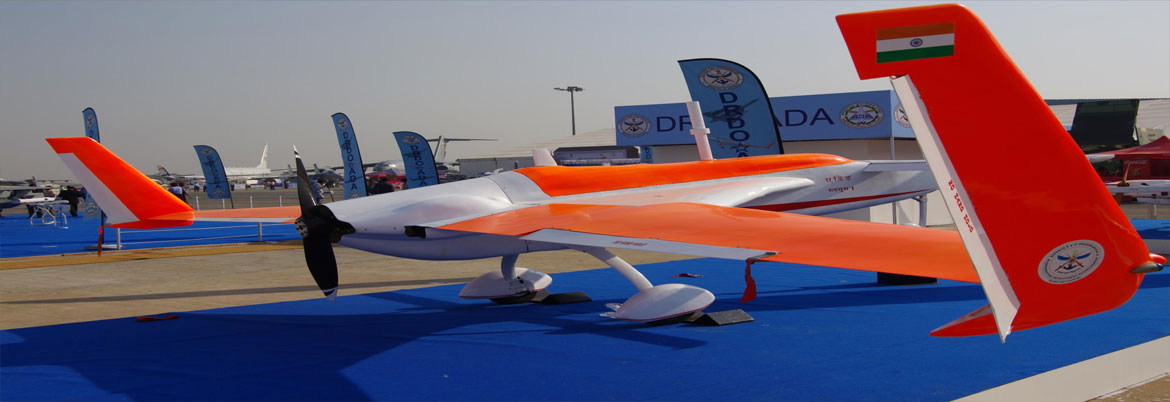
Rustom-1 Medium Altitude Long Endurance (MALE) Unmanned Aerial Vehicle (UAV) is poised to achieve Automatic Takeoff and Landing (ATOL) capability, setting the project up to become as stellar Make-in-India success story.
The Indian Army has been holding off orders for the drone awaiting ATOL capability, which would make the drone easier to operate. Currently, Rustom-1 is externally piloted during takeoff and landing.
Besides, being accident prone, external piloting imposes a short take-off run so as not to tax the pilot, which in turn limits the fuel and payload that the drone can carry. ATOL would allow Rustom-1 to achieve its designed endurance of 8 hours and altitude ceiling of 8000 meters.
Rustom-1 is being developed by the Aeronautical Development Establishment (ADE), a DRDO lab engaged in R&D work in the field of aeronautics, as a replacement for the Israeli supplied Searcher-II UAV.
Rustom-1 recently demonstrated its long endurance maritime surveillance capability in the coastal region of South India.
Automatic takeoff is relatively easier to achieve - sensors fitted on the drone detect any drift from the runway centerline and the autopilot immediately corrects the drift. An automatic landing system is more complex, since the UAV has to be automatically aligned to the runway can then brought down along an optimum glideslope.
Automated Landing System (ALS) for Rustom-1
In August 2014 ADE invited bids for supply of Cassidian MDR-NES Mini Laser Designator and Range Finder (MLDRF) as part of its project to develop an Automated Landing System (ALS) for Rustom-1
The ALS system includes a ground based Laser transmitter and receiver, and a Retro reflector on the UAV. ALS also has a Day TV Camera for streaming video that is monitored by a ground based pilot. After acquiring a UAV in its vicinity, the ALS continuously transmits Laser pulses and receives reflections from the retro reflectors on the UAV. The system uses the laser reflections to compute the dynamic position of the UAV (i.e. Distance, Azimuth and Elevation angles) and uplinks the data to the UAV autopilot for a safe landing.
Rustom-1 Utilization
Rustom- 1 is intended to be used for
- Reconnaissance & Surveillance
- Target Acquisition
- Target Designation
- Communication Relay
- Battle Damage Assessment
- Signal Intelligence.
Three armed forces and internal security organizations like State Police Forces, BSF, CRPF and Coast Guards, are the prospective users of Rustom –1.
Falling in Step with the Future
As a result of advances in electronics and robotics, drones are becoming increasingly capable and their military applications are increasing.
Military drones come at a fraction of the cost of manned aircraft with no risk to human lives. Mini and Micro drones are used for battlefield surveillance and targeting. Medium drones are used for ISR (Intelligence, Surveillance, and Reconnaissance). Armed medium drones are used for counter-insurgency. The US, UK, France and China are on the verge of fielding stealthy armed drones for SEAD (Suppression of Enemy Air Defense) missions. Work has started on the development of drones with air-combat capability. Eventually, it is expected that future aircraft would be optionally manned!
Indian Armed Forces were prompt to embrace drone technology. However, the domestic industry till recently ignored the potential of drones. As a result, Indian military meets almost all its drone requirements through imports from Israel.
India is currently the biggest importer of drones, accounting for 22.5 percent of the world's trade. Reliance on imported drones is fraught with risks besides being extremely expensive.
According to the Pentagon’s annual report to the Congress on the People’s Liberation Army (PLA), China’s military plans to produce nearly 42,000 land-based and sea-based unmanned weapons and sensor platforms as part of its continuing, large-scale military buildup.
DRDO's successful implementation of the Rustom-1 project, and the follow-up Rustom-2 project (Israeli Heron replacement) would help Indian military to add capability at reduced cost and with greater customization, while reducing import dependence.
No comments:
Post a Comment